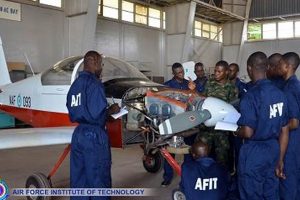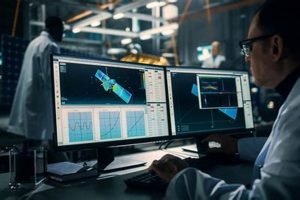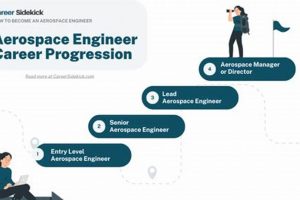This specialized field integrates principles from aeronautical and astronautical engineering with electrical engineering. Practitioners design, develop, and test electrical systems and components crucial for aircraft, spacecraft, satellites, and related equipment. This includes navigation systems, communication systems, control systems, and power systems, all of which must operate reliably under extreme environmental conditions. A flight control system within an aircraft, which utilizes sensors, actuators, and onboard computers to maintain stability and execute pilot commands, serves as a prime example.
The significance of this discipline lies in its contribution to the safety, performance, and efficiency of aerospace vehicles. Sophisticated electronic systems enable enhanced navigation, improved communication, and precise control, contributing to safer air travel and more effective space exploration. Historically, advancements in microelectronics and digital signal processing have propelled innovation in this area, leading to smaller, lighter, and more powerful electronic systems, enabling the development of increasingly complex and capable aerospace platforms. This also enhances military defense capabilities and the broader telecommunications infrastructure dependent on satellite technology.
The following sections will delve into specific applications within various aerospace domains, examining current research trends and emerging technologies shaping the future of flight and space exploration. We will also consider the professional pathways available to individuals seeking careers and discuss the educational requirements necessary to contribute meaningfully to this vital and rapidly evolving technological landscape.
This section provides essential guidance for those involved in or aspiring to join the field. These tips emphasize critical aspects that can contribute to success and advancement within this demanding discipline.
Tip 1: Solidify Foundational Knowledge. A robust understanding of core electrical engineering principles, including circuit analysis, signal processing, and electromagnetics, is paramount. Without a firm grasp of these basics, mastering specialized aerospace applications will prove challenging.
Tip 2: Embrace Interdisciplinary Learning. Integrate knowledge from diverse fields such as aerodynamics, propulsion, and materials science. Aerospace systems are complex and require a holistic perspective to design effective electronic solutions.
Tip 3: Master Relevant Software Tools. Proficiency in industry-standard software for circuit simulation (e.g., SPICE), embedded systems development, and data analysis is essential. Practical experience with these tools is highly valued.
Tip 4: Prioritize Robust Testing and Validation. Given the critical nature of aerospace applications, rigorous testing and validation protocols are crucial. Familiarize yourself with industry standards for environmental testing, reliability analysis, and fault tolerance.
Tip 5: Develop Strong Communication Skills. The ability to clearly articulate technical concepts and collaborate effectively with engineers from various disciplines is essential for project success. Practice writing concise technical reports and delivering presentations.
Tip 6: Stay Abreast of Technological Advancements. The discipline is constantly evolving. Continuously monitor advancements in areas such as microelectronics, sensor technology, and artificial intelligence to remain competitive.
Tip 7: Seek Out Mentorship Opportunities. Guidance from experienced engineers can provide invaluable insights into industry practices, career development, and navigating complex technical challenges.
Adherence to these guidelines can enhance technical competency, improve professional effectiveness, and facilitate contributions to the development of safe and reliable aerospace systems.
The subsequent section will summarize the critical attributes and educational paths to forge a successful journey in this specialized engineering discipline.
1. Reliability
Reliability is a cornerstone principle in aerospace electronics engineering. The operational environments and safety-critical nature of aerospace systems demand an uncompromising focus on the dependability and longevity of electronic components and systems. Failure can lead to catastrophic consequences, thus necessitating rigorous design, testing, and quality assurance protocols.
- Component Selection and Derating
Choosing electronic components with proven reliability records and employing derating strategies are crucial. Derating involves operating components below their maximum rated values (voltage, current, power) to reduce stress and extend their lifespan. For instance, resistors might be chosen with higher power ratings than theoretically required, mitigating the risk of overheating and failure. Example, choosing military-grade components over commercial-grade components when environmental stressors in space are concerned.
- Redundancy and Fault Tolerance
Implementing redundancy, where critical functions are duplicated or triplicated, ensures continued operation even if one component fails. Fault-tolerant designs incorporate error detection and correction mechanisms to automatically compensate for failures. Aircraft flight control systems often employ multiple independent computers that continuously monitor each other, switching to a backup system if a fault is detected. Also, communication satellites often have redundant transponders and control systems to ensure continuous service even if one component fails.
- Environmental Testing and Qualification
Aerospace electronics must withstand extreme temperatures, vibration, shock, and radiation. Environmental testing subjects components and systems to these conditions to identify potential weaknesses and verify their ability to perform reliably. Qualification processes ensure that components meet stringent standards for performance and reliability under simulated or actual operating conditions. Examples include temperature cycling, vibration testing, and radiation exposure in specialized facilities.
- Failure Mode and Effects Analysis (FMEA)
FMEA is a systematic process for identifying potential failure modes in a system and evaluating their effects on overall system performance. This analysis helps engineers prioritize risks and implement appropriate mitigation strategies, such as design changes or improved testing procedures. FMEA is routinely used to analyze complex aerospace systems, ensuring all critical functions are robustly tested and protected against unforeseen failures.
The pursuit of reliability in aerospace electronics engineering is a multifaceted endeavor encompassing meticulous design, rigorous testing, and stringent quality control. These measures collectively contribute to the safety, effectiveness, and longevity of aerospace systems, ranging from commercial airliners to space exploration vehicles. The ongoing development of new materials, advanced manufacturing techniques, and improved diagnostic tools continuously advances the field’s ability to engineer increasingly reliable electronic systems for the demanding aerospace environment.
2. Integration
Integration, within the context of aerospace electronics engineering, signifies the cohesive assembly of disparate electronic components, subsystems, and software elements into a unified and functional aerospace system. This process transcends simple physical connections; it encompasses ensuring seamless communication, data exchange, and operational compatibility between all constituent parts. The success of any aerospace system hinges critically on the effectiveness of its integration processes. Poor integration leads to system instability, degraded performance, and potentially catastrophic failures. An illustrative example lies in modern aircraft, where navigation systems, flight control computers, engine management systems, and communication equipment must operate in perfect synchronicity to guarantee safe and efficient flight. The intricate web of sensors, actuators, and processors necessitates meticulous integration to achieve desired performance and safety standards. In turn, the development time and reliability of aerospace systems are both directly and positively influenced.
Further examples can be found in satellite systems. Integrating various payloads, such as communication transponders, scientific instruments, and power management units, presents substantial integration challenges. Each payload possesses unique operational characteristics, requiring customized interfaces and communication protocols. System integrators must address electromagnetic compatibility issues to prevent interference between different subsystems. Furthermore, thermal management plays a vital role, as different components generate varying amounts of heat, impacting the overall system’s stability and lifespan. Integration considerations also extend to software. Avionics software integration involves complex processes of ensuring compliance with industry standards, rigorous testing, and careful configuration management to mitigate risks and maintain system performance. The need for specialized interfaces between hardware and software components is crucial to ensure that each aspect functions correctly during deployment.
In conclusion, integration is not merely a technical task within aerospace electronics engineering; it is a strategic imperative. Effective integration serves as the bedrock for robust, high-performing aerospace systems. Addressing the inherent complexities of integrating diverse electronic elements requires a holistic approach, encompassing meticulous planning, rigorous testing, and close collaboration between engineers from various disciplines. Challenges persist, including the ever-increasing complexity of aerospace systems and the need for greater automation in the integration process. However, ongoing advancements in modeling and simulation tools, automated testing techniques, and standardized communication protocols are paving the way for more efficient and reliable integration methodologies. As aerospace systems become ever more sophisticated, the importance of effective integration will only continue to amplify, underscoring its central role in shaping the future of flight and space exploration.
3. Miniaturization
Miniaturization is an essential driver in the evolution of aerospace electronics engineering. The relentless pursuit of smaller, lighter, and more efficient electronic systems is not merely a design preference; it is a fundamental requirement dictated by the unique constraints of the aerospace environment. Reduced size and weight directly correlate with improved fuel efficiency in aircraft and increased payload capacity for spacecraft. Furthermore, smaller components enable the design of more compact and integrated systems, maximizing available space within the limited confines of aerospace vehicles. Consider the evolution of avionics systems: Early systems occupied entire rooms within aircraft, whereas contemporary systems are integrated into relatively small, lightweight modules. This transformation has been enabled by advancements in microelectronics, microelectromechanical systems (MEMS), and advanced packaging techniques.
The practical implications of miniaturization extend beyond simple weight and volume reductions. Smaller electronic components often exhibit improved performance characteristics, such as faster switching speeds and lower power consumption. These improvements are particularly critical for applications like high-speed data processing and signal acquisition. GPS receivers used in aircraft navigation have undergone significant miniaturization, evolving from bulky, power-hungry units to compact, energy-efficient devices integrated into handheld units and even wearable devices. Similarly, the size reduction in microprocessors has enabled the development of highly sophisticated flight control systems capable of executing complex algorithms in real time. The development of CubeSats showcases the significance of miniaturization in space technology. These small satellites pack sophisticated sensors, communication systems, and power supplies into a volume of just a few liters, enabling cost-effective space exploration and scientific research.
The drive for miniaturization presents significant engineering challenges, including thermal management, electromagnetic interference (EMI) control, and reliability assurance. As components shrink, heat dissipation becomes more difficult, potentially leading to overheating and failure. Moreover, the close proximity of electronic circuits increases the risk of EMI, which can compromise system performance. Despite these challenges, continuous advancements in materials science, manufacturing processes, and packaging technologies are enabling engineers to push the boundaries of miniaturization. Nanotechnology and three-dimensional integrated circuits (3D ICs) hold significant promise for future breakthroughs. These technologies will allow for the creation of even smaller, more powerful, and more reliable electronic systems, further enhancing the capabilities of aerospace vehicles. In summary, miniaturization is a central pillar of aerospace electronics engineering, driving innovation and enabling the development of ever-more sophisticated and capable aerospace platforms.
4. Radiation Hardening
Radiation hardening is an indispensable aspect within aerospace electronics engineering, crucial for ensuring the reliable operation of electronic systems in radiation-rich environments, particularly in space. The natural space environment exposes electronic components to various forms of radiation, including cosmic rays, trapped particles in the Earth’s magnetosphere, and solar flares. These energetic particles can cause temporary and permanent damage to electronic devices, leading to performance degradation or complete failure. Thus, specialized techniques and design considerations are implemented to mitigate the effects of radiation on aerospace electronics.
- Component Selection and Shielding
The selection of radiation-tolerant components is a primary strategy. Certain semiconductor materials and device architectures are inherently more resistant to radiation effects. Shielding, using materials like aluminum or tantalum, reduces the radiation dose reaching sensitive components. The effectiveness of shielding depends on the energy of the radiation and the thickness and density of the shielding material. For example, satellites operating in geostationary orbit often require significant shielding to protect against prolonged exposure to trapped electrons and protons. Critical electronic components are encased in radiation-shielding materials.
- Radiation-Hardened by Design (RHBD)
This involves designing circuits and systems with specific architectural and layout techniques that make them less susceptible to radiation damage. Triple modular redundancy (TMR), where three identical circuits perform the same function and a voting circuit selects the output with the majority agreement, is a common example. This approach allows the system to tolerate a single-event upset (SEU) in one of the circuits without compromising overall system functionality. Another technique involves using guard rings around sensitive transistors to collect radiation-induced charge carriers, preventing them from affecting device performance. Integrated circuits intended for use in space are designed from the ground up to be resistant to radiation damage.
- Software Mitigation Techniques
Software can play a crucial role in mitigating radiation effects. Error detection and correction codes (EDAC) are used to detect and correct bit flips in memory caused by radiation. Scrubbing, which involves periodically rewriting memory locations to correct errors, is another common technique. Real-time operating systems (RTOS) designed for space applications often incorporate features for detecting and mitigating radiation-induced errors. Software-based fault tolerance schemes monitor critical system parameters and automatically switch to redundant systems if a fault is detected. Spacecraft flight software often incorporates error-correcting codes to mitigate the effects of radiation-induced memory errors.
- Testing and Validation
Rigorous testing and validation are essential to ensure that radiation-hardened electronic systems meet performance requirements. Ground-based radiation testing facilities are used to simulate the space radiation environment. These facilities use particle accelerators and radioactive sources to expose components and systems to controlled doses of radiation. Testing involves monitoring system performance during and after radiation exposure to identify potential weaknesses. Flight testing, where electronic systems are flown on rockets or satellites, provides a real-world assessment of their radiation tolerance. Actual flight data is compared with ground test results to validate the effectiveness of radiation-hardening techniques. Prototypes of spacecraft components are tested in radiation chambers to verify their resilience to space conditions.
These facets, when collectively applied within the domain of aerospace electronics engineering, contribute to the creation of resilient electronic systems capable of enduring the harsh radiation environments encountered in space. The ongoing development of new radiation-hardening techniques and materials remains a critical area of research, driven by the increasing demand for more sophisticated and reliable electronic systems for space exploration and satellite communications. The integration of radiation-hardening considerations throughout the design and development process is essential for ensuring the success of aerospace missions.
5. Signal Processing
Signal processing constitutes a core discipline within aerospace electronics engineering. It encompasses the acquisition, analysis, manipulation, and interpretation of signals derived from various sensors and sources essential for the operation and control of aerospace systems. The effectiveness of signal processing directly impacts the performance, safety, and reliability of these systems.
- Radar and Sonar Signal Processing
Aerospace systems rely heavily on radar and sonar for navigation, surveillance, and target tracking. Signal processing techniques are employed to extract relevant information from the received radar and sonar signals, such as target range, velocity, and direction. Advanced algorithms mitigate the effects of noise, clutter, and interference, enhancing the accuracy and reliability of target detection and tracking. Airborne radar systems utilize sophisticated signal processing to map terrain, detect weather formations, and guide aircraft in adverse weather conditions. Sonar systems are used in underwater applications for submarine navigation and detection.
- Communication Signal Processing
Robust communication links are vital for aerospace operations, enabling data transmission between aircraft, spacecraft, ground stations, and control centers. Signal processing techniques are used to modulate and demodulate signals, compress data, and correct errors introduced by noise and interference in the communication channel. Advanced modulation schemes, such as orthogonal frequency-division multiplexing (OFDM), improve data transmission rates and spectral efficiency. Error-correcting codes, such as Reed-Solomon codes, are used to enhance the reliability of communication links, especially in harsh environments. Satellite communication systems use sophisticated signal processing to overcome signal attenuation and interference caused by atmospheric conditions.
- Sensor Signal Processing
Aerospace systems incorporate a wide array of sensors to monitor various parameters, such as temperature, pressure, acceleration, and altitude. Signal processing techniques are applied to filter noise, calibrate sensor outputs, and extract meaningful information from sensor data. Kalman filtering, for example, is used to estimate the state of a dynamic system based on noisy sensor measurements. Inertial navigation systems (INS) rely on sophisticated signal processing to integrate data from accelerometers and gyroscopes to determine the position and orientation of an aircraft or spacecraft. Engine monitoring systems use signal processing to detect anomalies in engine performance, enabling timely maintenance and preventing catastrophic failures. For example, vibration monitoring in turbofan engines uses fast Fourier transforms (FFT) to detect abnormal vibration signatures, indicating potential mechanical problems.
- Image and Video Processing
Aerospace applications increasingly rely on image and video processing for remote sensing, surveillance, and autonomous navigation. Signal processing techniques are used to enhance image quality, extract features, and recognize objects in images and videos. Image enhancement algorithms improve contrast and reduce noise, making it easier to identify objects of interest. Object recognition algorithms are used to automatically detect and classify targets in aerial imagery. Autonomous vehicles utilize computer vision techniques to navigate complex environments, avoiding obstacles and tracking targets. Satellite-based imaging systems use sophisticated signal processing to generate high-resolution images of the Earth’s surface for environmental monitoring and resource management.
In conclusion, signal processing is an integral component of aerospace electronics engineering, enabling the effective acquisition, analysis, and interpretation of data critical for the safe and efficient operation of aerospace systems. Ongoing advancements in signal processing algorithms and hardware are continuously expanding the capabilities of aerospace vehicles, enabling new applications in areas such as autonomous flight, space exploration, and remote sensing. As aerospace systems become increasingly complex and data-intensive, the importance of signal processing will only continue to grow, underscoring its central role in shaping the future of flight and space technology.
6. Cybersecurity
Cybersecurity is an increasingly critical component within aerospace electronics engineering. The growing reliance on interconnected digital systems in aircraft, spacecraft, and ground infrastructure creates vulnerabilities that malicious actors can exploit. A successful cyberattack could compromise navigation systems, flight control, communication networks, or even critical infrastructure, potentially leading to severe consequences, including loss of life, financial damage, and national security breaches. The shift toward networked avionics, increased reliance on satellite communications, and the integration of commercial off-the-shelf (COTS) components have widened the attack surface, making aerospace systems more susceptible to cyber threats. One example is the potential hijacking of an aircraft’s control systems through vulnerabilities in its onboard entertainment or Wi-Fi systems, as demonstrated in various security research scenarios. Another case is the jamming or spoofing of GPS signals, which can disrupt navigation and timing systems, impacting air traffic control and precision-guided munitions.
The integration of cybersecurity measures into aerospace electronics engineering is a multi-layered approach encompassing design, implementation, and maintenance. Secure system architecture involves implementing robust authentication mechanisms, access controls, and data encryption. Security testing and vulnerability assessments are essential for identifying and mitigating potential weaknesses before deployment. Incident response planning and cybersecurity awareness training are critical for preparing personnel to respond effectively to cyberattacks. The development of standardized cybersecurity protocols and frameworks specifically tailored to aerospace applications is essential for promoting interoperability and ensuring consistent security practices. The US Federal Aviation Administration (FAA) has issued guidance and regulations for addressing cybersecurity risks in aviation systems, emphasizing the importance of collaboration between government, industry, and academia. An example is the implementation of intrusion detection systems that monitor network traffic for suspicious activity. Also, strong encryption of communication links between aircraft and ground stations is essential to prevent eavesdropping and data tampering.
The evolving nature of cyber threats requires continuous adaptation and innovation in aerospace electronics engineering. Emerging technologies like artificial intelligence and machine learning can be leveraged to enhance threat detection and response capabilities. However, these technologies also introduce new cybersecurity challenges that must be addressed. Quantum-resistant cryptography is being explored to protect against future attacks from quantum computers. Collaboration and information sharing among industry stakeholders, government agencies, and research institutions are crucial for staying ahead of cyber threats. The need for robust cybersecurity measures in aerospace electronics engineering is paramount to safeguarding the safety, security, and reliability of aerospace systems and protecting against potentially catastrophic consequences. The practical significance of this understanding is growing exponentially with the increased reliance on digital technologies in aviation and space exploration, demanding constant vigilance and innovation in cybersecurity practices.
Frequently Asked Questions
This section addresses common inquiries and misconceptions surrounding aerospace electronics engineering, offering concise and informative answers.
Question 1: What distinguishes aerospace electronics engineering from general electrical engineering?
Aerospace electronics engineering focuses on designing, developing, and testing electronic systems specifically for use in aircraft, spacecraft, and related applications. This specialization requires expertise in dealing with the unique environmental challenges and performance demands of the aerospace domain, such as extreme temperatures, vibration, radiation, and stringent safety requirements. General electrical engineering encompasses a broader range of applications across various industries.
Question 2: What are the primary job roles available to graduates with a degree in aerospace electronics engineering?
Graduates can pursue careers in a variety of roles, including avionics systems engineer, spacecraft electronics designer, embedded systems developer, flight control systems engineer, radar systems engineer, and reliability engineer. These roles often involve working with aerospace manufacturers, government agencies (such as NASA), and defense contractors.
Question 3: What fundamental skills are essential for success in aerospace electronics engineering?
Essential skills include a strong foundation in circuit analysis, signal processing, embedded systems, communication systems, and control theory. Proficiency in relevant software tools for simulation, design, and testing is also critical. Strong analytical and problem-solving abilities, along with excellent communication skills, are necessary for effective collaboration within multidisciplinary teams.
Question 4: How does radiation hardening factor into aerospace electronics engineering?
Radiation hardening is a crucial consideration, particularly for space-based applications. It involves designing and implementing electronic systems that are resistant to the damaging effects of radiation encountered in space. This includes selecting radiation-tolerant components, implementing shielding techniques, and utilizing fault-tolerant architectures to ensure reliable operation in the harsh space environment.
Question 5: What are the current trends shaping the future of aerospace electronics engineering?
Several trends are influencing the field, including the increasing demand for miniaturization, the integration of artificial intelligence and machine learning, the development of autonomous systems, and the growing emphasis on cybersecurity. Advancements in microelectronics, sensor technology, and advanced materials are also driving innovation in the field.
Question 6: What are the typical educational requirements for pursuing a career in aerospace electronics engineering?
A bachelor’s degree in electrical engineering, aerospace engineering, or a closely related field is generally required. Many positions, particularly those involving advanced research or design, require a master’s degree or a doctorate. Specialized coursework in aerospace electronics, avionics, and related subjects is highly recommended. Hands-on experience through internships or research projects is also valuable.
This FAQ section provides an overview of key aspects related to aerospace electronics engineering. It highlights the specialized nature of the field, the diverse career opportunities available, the essential skills required, and the challenges and trends shaping its future.
The following section will provide a summary encapsulating the main points of this article.
Aerospace Electronics Engineering
This exploration has underscored the multifaceted nature of aerospace electronics engineering, a discipline vital to the advancement and security of air and space travel. The discussion has traversed core aspects including the crucial need for reliability under extreme conditions, the imperative of seamless systems integration, the constant drive for miniaturization, the indispensable element of radiation hardening, the sophisticated techniques of signal processing, and the ever-growing significance of cybersecurity. The FAQ section has further clarified key distinctions, career paths, and the educational foundation required for meaningful contribution to this demanding field.
As technological innovation accelerates, aerospace electronics engineering faces continuous evolution. Sustained dedication to research, development, and rigorous application of core principles remains paramount. Continued progress will not only drive future advancements in flight and space exploration, but also ensure the integrity and resilience of critical infrastructure upon which global aerospace activities depend. The ongoing investment in education, training, and collaborative efforts is essential for cultivating the next generation of engineers capable of addressing the complex challenges that lie ahead.







